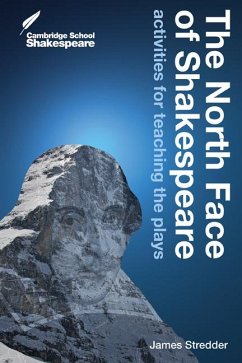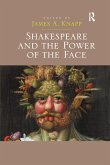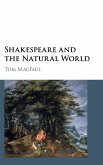James Stredder
The North Face of Shakespeare
James Stredder
The North Face of Shakespeare
- Broschiertes Buch
- Merkliste
- Auf die Merkliste
- Bewerten Bewerten
- Teilen
- Produkt teilen
- Produkterinnerung
- Produkterinnerung
A wealth of expert advice and practical ideas for teaching the plays.
Andere Kunden interessierten sich auch für
![Shakespeare and the Power of the Face Shakespeare and the Power of the Face]() James A. KnappShakespeare and the Power of the Face64,99 €
James A. KnappShakespeare and the Power of the Face64,99 €![Shakespeare and the Hunt Shakespeare and the Hunt]() Edward BerryShakespeare and the Hunt69,99 €
Edward BerryShakespeare and the Hunt69,99 €![Shakespeare and the Hunt Shakespeare and the Hunt]() Edward BerryShakespeare and the Hunt42,99 €
Edward BerryShakespeare and the Hunt42,99 €![Shakespeare and the Natural World Shakespeare and the Natural World]() Tom MacfaulShakespeare and the Natural World34,99 €
Tom MacfaulShakespeare and the Natural World34,99 €![The Heart in the Age of Shakespeare The Heart in the Age of Shakespeare]() William W. E. SlightsThe Heart in the Age of Shakespeare36,99 €
William W. E. SlightsThe Heart in the Age of Shakespeare36,99 €![Shakespeare and the Book Shakespeare and the Book]() David Scott KastanShakespeare and the Book69,99 €
David Scott KastanShakespeare and the Book69,99 €![Shakespeare and the Natural World Shakespeare and the Natural World]() Tom MacfaulShakespeare and the Natural World73,99 €
Tom MacfaulShakespeare and the Natural World73,99 €-
-
-
A wealth of expert advice and practical ideas for teaching the plays.
Hinweis: Dieser Artikel kann nur an eine deutsche Lieferadresse ausgeliefert werden.
Hinweis: Dieser Artikel kann nur an eine deutsche Lieferadresse ausgeliefert werden.
Produktdetails
- Produktdetails
- Verlag: Cambridge University Press
- Seitenzahl: 306
- Erscheinungstermin: 7. September 2009
- Englisch
- Abmessung: 229mm x 152mm x 17mm
- Gewicht: 446g
- ISBN-13: 9780521756365
- ISBN-10: 0521756367
- Artikelnr.: 27352430
- Herstellerkennzeichnung
- Libri GmbH
- Europaallee 1
- 36244 Bad Hersfeld
- gpsr@libri.de
- Verlag: Cambridge University Press
- Seitenzahl: 306
- Erscheinungstermin: 7. September 2009
- Englisch
- Abmessung: 229mm x 152mm x 17mm
- Gewicht: 446g
- ISBN-13: 9780521756365
- ISBN-10: 0521756367
- Artikelnr.: 27352430
- Herstellerkennzeichnung
- Libri GmbH
- Europaallee 1
- 36244 Bad Hersfeld
- gpsr@libri.de
Introduction
Using this book
The organisation and content of the eight chapters
Developing the use of drama to teach Shakespeare
The teacher's autonomy
Section 1. Active Teaching: 1. Why use active methods to teach the plays? The North Face of Shakespeare
The problem of monumentalism
The teacher repositioned: 'Shakespeare shared'
Starting active work
Drama workshops
The learner and the text at the centre
Active Shakespeare and independent learning
Back to the art of teaching - and student achievement
2. Practical work and drama workshops
The classroom as stage: activities in conventional teaching sessions
Safety: physical and emotional
Different needs and abilities
Workshop practices
Workshop objectives and the use of warm-ups and preparation exercises
Workshop planning: an example of a language workshop - 'Macbeth's soliloquies'
The origins of the workshop activities in the following chapters
Section 2. Activities for Teaching Shakespeare's Plays: 3. Group formation activities
Group formation
Getting started
4. Drama games: using games in the Shakespeare workshop
5. Drama exercises: using drama exercises in the Shakespeare workshop
6. Shakespeare's language: the aims of language work
Shakespeare's language gives 'the motive and the cue' for action
Discourse and rhetoric as sources of dramatic energy and action
Language ownership and familiarity through workshops
Teaching approaches: listen and speak, active reading, learn and act
7. Narrative in Shakespeare: harnessing the power of narrative's theatricality
The nature of Shakespeare's narratives
Teaching approaches: Structural approaches, dynamic approaches, investigative approaches
8. Character in Shakespeare: changing ideas about character in drama
Characters and their speech utterances
Role differentiated from character
Character and setting
Mise en scene
Teaching approaches: personal encounters with roles
Roles in social settings
Roles in action in the narrative
Notes
References
Index.
Using this book
The organisation and content of the eight chapters
Developing the use of drama to teach Shakespeare
The teacher's autonomy
Section 1. Active Teaching: 1. Why use active methods to teach the plays? The North Face of Shakespeare
The problem of monumentalism
The teacher repositioned: 'Shakespeare shared'
Starting active work
Drama workshops
The learner and the text at the centre
Active Shakespeare and independent learning
Back to the art of teaching - and student achievement
2. Practical work and drama workshops
The classroom as stage: activities in conventional teaching sessions
Safety: physical and emotional
Different needs and abilities
Workshop practices
Workshop objectives and the use of warm-ups and preparation exercises
Workshop planning: an example of a language workshop - 'Macbeth's soliloquies'
The origins of the workshop activities in the following chapters
Section 2. Activities for Teaching Shakespeare's Plays: 3. Group formation activities
Group formation
Getting started
4. Drama games: using games in the Shakespeare workshop
5. Drama exercises: using drama exercises in the Shakespeare workshop
6. Shakespeare's language: the aims of language work
Shakespeare's language gives 'the motive and the cue' for action
Discourse and rhetoric as sources of dramatic energy and action
Language ownership and familiarity through workshops
Teaching approaches: listen and speak, active reading, learn and act
7. Narrative in Shakespeare: harnessing the power of narrative's theatricality
The nature of Shakespeare's narratives
Teaching approaches: Structural approaches, dynamic approaches, investigative approaches
8. Character in Shakespeare: changing ideas about character in drama
Characters and their speech utterances
Role differentiated from character
Character and setting
Mise en scene
Teaching approaches: personal encounters with roles
Roles in social settings
Roles in action in the narrative
Notes
References
Index.
Introduction
Using this book
The organisation and content of the eight chapters
Developing the use of drama to teach Shakespeare
The teacher's autonomy
Section 1. Active Teaching: 1. Why use active methods to teach the plays? The North Face of Shakespeare
The problem of monumentalism
The teacher repositioned: 'Shakespeare shared'
Starting active work
Drama workshops
The learner and the text at the centre
Active Shakespeare and independent learning
Back to the art of teaching - and student achievement
2. Practical work and drama workshops
The classroom as stage: activities in conventional teaching sessions
Safety: physical and emotional
Different needs and abilities
Workshop practices
Workshop objectives and the use of warm-ups and preparation exercises
Workshop planning: an example of a language workshop - 'Macbeth's soliloquies'
The origins of the workshop activities in the following chapters
Section 2. Activities for Teaching Shakespeare's Plays: 3. Group formation activities
Group formation
Getting started
4. Drama games: using games in the Shakespeare workshop
5. Drama exercises: using drama exercises in the Shakespeare workshop
6. Shakespeare's language: the aims of language work
Shakespeare's language gives 'the motive and the cue' for action
Discourse and rhetoric as sources of dramatic energy and action
Language ownership and familiarity through workshops
Teaching approaches: listen and speak, active reading, learn and act
7. Narrative in Shakespeare: harnessing the power of narrative's theatricality
The nature of Shakespeare's narratives
Teaching approaches: Structural approaches, dynamic approaches, investigative approaches
8. Character in Shakespeare: changing ideas about character in drama
Characters and their speech utterances
Role differentiated from character
Character and setting
Mise en scene
Teaching approaches: personal encounters with roles
Roles in social settings
Roles in action in the narrative
Notes
References
Index.
Using this book
The organisation and content of the eight chapters
Developing the use of drama to teach Shakespeare
The teacher's autonomy
Section 1. Active Teaching: 1. Why use active methods to teach the plays? The North Face of Shakespeare
The problem of monumentalism
The teacher repositioned: 'Shakespeare shared'
Starting active work
Drama workshops
The learner and the text at the centre
Active Shakespeare and independent learning
Back to the art of teaching - and student achievement
2. Practical work and drama workshops
The classroom as stage: activities in conventional teaching sessions
Safety: physical and emotional
Different needs and abilities
Workshop practices
Workshop objectives and the use of warm-ups and preparation exercises
Workshop planning: an example of a language workshop - 'Macbeth's soliloquies'
The origins of the workshop activities in the following chapters
Section 2. Activities for Teaching Shakespeare's Plays: 3. Group formation activities
Group formation
Getting started
4. Drama games: using games in the Shakespeare workshop
5. Drama exercises: using drama exercises in the Shakespeare workshop
6. Shakespeare's language: the aims of language work
Shakespeare's language gives 'the motive and the cue' for action
Discourse and rhetoric as sources of dramatic energy and action
Language ownership and familiarity through workshops
Teaching approaches: listen and speak, active reading, learn and act
7. Narrative in Shakespeare: harnessing the power of narrative's theatricality
The nature of Shakespeare's narratives
Teaching approaches: Structural approaches, dynamic approaches, investigative approaches
8. Character in Shakespeare: changing ideas about character in drama
Characters and their speech utterances
Role differentiated from character
Character and setting
Mise en scene
Teaching approaches: personal encounters with roles
Roles in social settings
Roles in action in the narrative
Notes
References
Index.








